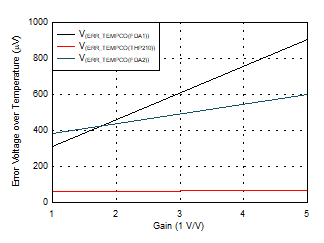ZHCSKT9C January 2020 – March 2021 THP210
PRODUCTION DATA
- 1 特性
- 2 应用
- 3 说明
- 4 Revision History
- 5 Pin Configuration and Functions
- 6 Specifications
- 7 Parameter Measurement Information
- 8 Detailed Description
-
9 Application and Implementation
- 9.1 Application Information
- 9.2 Typical Applications
- 10Power Supply Recommendations
- 11Layout
- 12Device and Documentation Support
- 13Mechanical, Packaging, and Orderable Information
9.1.2.2 DC Error Voltage Over Temperature
The THP210 offers excellent dc accuracy at room temperature. In many applications, calibration techniques are used to minimize the initial dc error; however, performing calibration over temperature is time-consuming and expensive.
The advanced drift specification of the THP210 helps to further mitigate the system error over temperature. Figure 9-3 depicts the total error voltage at these given conditions:
- Circuit configuration as shown in Figure 9-2
- Temperature range from –40°C to +125°C
- Resistor tolerance of 1%
 Figure 9-3 Calculation of Error Voltage
Over Temperature at Different Gain Settings (Variable R2)
Figure 9-3 Calculation of Error Voltage
Over Temperature at Different Gain Settings (Variable R2)The main contributors that are considered in this analysis are offset voltage drift, offset current drift, and bias current drift. As a result of the ultra-low bias current drift of 15 pA/°C, the impact of higher gain resistors and resistor tolerances marginally affects the error voltage with the THP210.
A use case at a gain of 5 V/V shows that the total dc error over temperature of the THP210 is at 66 µV, which is at least a factor of 10 smaller compared to existing, state-of-the-art FDAs.